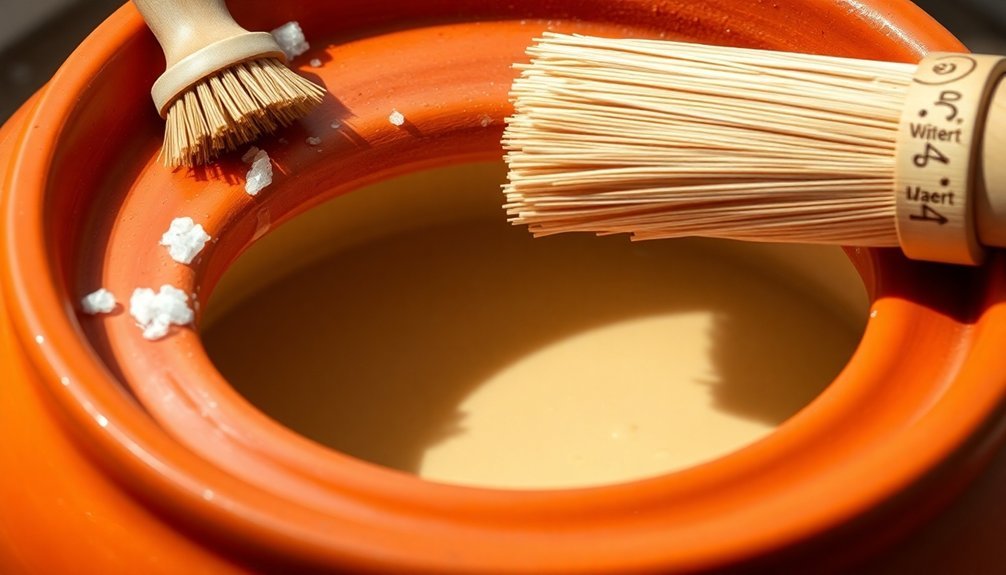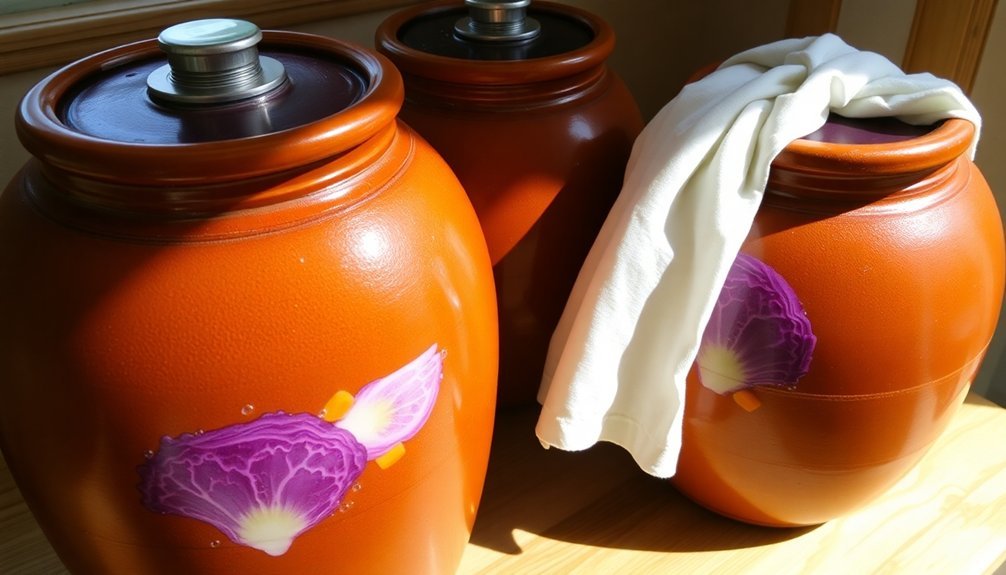Clay pots will revolutionize your home fermentation with three game-changing secrets. First, you'll benefit from their natural temperature regulation – the porous walls maintain ideal temps between 60-70°F while allowing essential gas exchange. Second, you'll reveal richer flavors as the clay's alkaline properties balance pH levels and encourage beneficial bacteria growth, resulting in more complex tastes. Third, you'll master easy maintenance by using simple vinegar-water solutions for cleaning and preventing contamination. These traditional vessels offer an authentic fermentation experience that's both practical and rewarding. Let's explore how these secrets can elevate your fermentation journey.
Perfect Temperature Every Time

Maintaining the perfect fermentation temperature doesn't have to be complicated. Your clay pot ferments will thrive when kept between 60°F and 70°F, with an ideal sweet spot around 65°F for most projects like sauerkraut, pickles, and kimchi.
You'll need reliable temperature monitoring to guarantee success. Attach a self-adhesive thermometer strip directly to your clay pot, or use a digital thermometer with high and low tracking capabilities. Remember to check temperatures regularly and record any fluctuations. Reptile thermostats provide an affordable way to monitor and control your fermentation temperatures with precision.
In cooler environments, wrap your clay pot with a fermentation heat wrap or place it on a seedling mat connected to a temperature controller. You can also create an insulated setup by placing your pot in a box lined with blankets to retain natural heat.
When temperatures rise too high, cool your clay pot by wrapping it with wet towels – the evaporation will help maintain ideal conditions. For more precise cooling, place your pot in a water bath with ice packs.
If you're fermenting regularly, consider investing in a dedicated temperature-controlled space using a modified window air conditioner or kegerator setup.
Natural Flavor Enhancement
Release deeper, richer flavors in your fermented foods by harnessing the unique properties of clay pots. The porous nature of clay creates an ideal environment where beneficial bacteria thrive, leading to more complex and authentic flavors in your fermented foods.
As moisture evaporates through the clay walls, it concentrates your ferments while maintaining optimal temperatures through natural cooling. This process mirrors the deoxygenated environment that commercial producers use to speed up fermentation.
You'll notice the difference when fermenting traditional foods like yogurt, kimchi, or sauerkraut. Clay pots' alkaline properties help balance the pH of your ferments, while their porous structure allows essential gas exchange during the fermentation process.
When you're making Bulgarian-style yogurt, for example, the clay pot's moisture absorption creates a smooth, rich texture through low-temperature fermentation.
The versatility of clay pots means you can experiment with various ferments, from dosa batter to kefir. You won't need artificial temperature control because the clay naturally regulates the environment.
The result? Your fermented foods will develop deeper flavors and better textures, thanks to the enhanced bacterial activity and natural concentration process that occurs within these traditional vessels.
Foolproof Cleaning Methods

A spotless clay pot forms the foundation for successful fermentation. You'll want to start with hot, soapy water and a mild detergent to clean your crock and stones thoroughly. After scrubbing away visible residue, use vinegar wipes on all surfaces before allowing them to air dry completely. Regular cleaning maintenance helps prevent contamination over time.
For stubborn mold or persistent odors, you've got several powerful options. Create a vinegar and hot water solution to soak your stones overnight, or use a baking soda solution for particularly tough smells. You can also boil your weights in a 50/50 water-vinegar mixture for 10-20 minutes to eliminate bacteria and unwanted odors.
To prevent future contamination, visualize these essential steps:
- Separate stones during cleaning so every surface gets thoroughly cleaned
- Line storage areas with newspaper to maintain ideal dryness
- Inspect for any signs of mold before each use
- Store components individually in a moisture-free environment
For ceramic pots, you can run them through the dishwasher and then bake at 400 degrees for two hours to eliminate any lingering viruses or salts.
Remember to avoid plastic materials and stick to non-reactive options like wood, ceramic, or glass for all your fermentation equipment.
Frequently Asked Questions
How Long Does a Clay Pot Typically Last Before Needing Replacement?
You'll find your clay pot lasting anywhere from 5-20 years with proper care. It depends on your maintenance routine, storage practices, and how often you use it. Regular inspections help maximize its lifespan.
Can Clay Pots Be Used in Refrigerators for Cold Fermentation?
You can use clay pots in refrigerators, but it's not necessary since the fridge already provides cooling. The pot's evaporative cooling properties won't function in the cold, humid refrigerator environment.
What Signs Indicate a Clay Pot Is No Longer Safe to Use?
You'll need to retire your clay pot if you notice cracks, persistent odors, mold growth, flaking surfaces, or damaged glazing. Don't use pots with stains that won't clean off or structural weaknesses.
Are All Types of Clay Pots Equally Effective for Fermentation?
No, you'll find different clay pots vary in effectiveness based on their firing temperature, porosity, and clay type. Higher-fired pots reduce oxygen exchange, while lower-fired ones allow more gas movement during fermentation.
Can I Use Clay Pots for Fermenting High-Salt Content Foods?
Yes, you can use clay pots for high-salt ferments, but make certain they're glazed to prevent chemical leaching. You'll need to verify the pot is non-reactive and properly sanitized for safe fermentation.
In Summary
You'll never go wrong with clay pots for your fermentation projects. They maintain ideal temperatures naturally, enhance the subtle flavors of your ingredients, and clean up easily with the right techniques. Whether you're making kimchi, sauerkraut, or kombucha, these three clay pot secrets will transform your fermentation game. Start implementing them today, and you'll soon enjoy consistently delicious fermented foods.





Leave a Reply